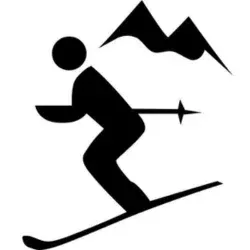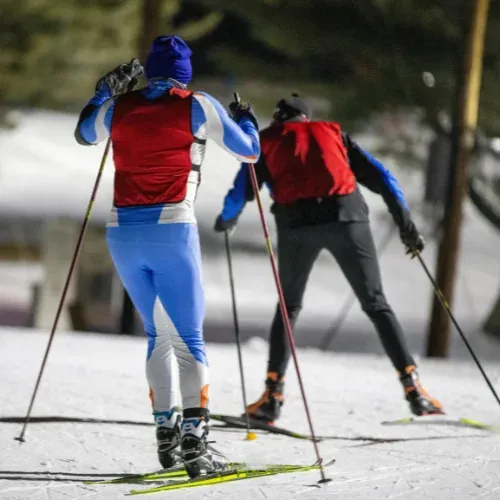Key Takeaways:
- The ideal skate ski pole length is typically between 90% to 95% of the skier's height.
- Choosing the right pole length is crucial for optimizing performance and comfort in skate skiing.
- Personal preference and ski technique play significant roles in determining the perfect pole size.

Skate skiing is a dynamic form of cross-country skiing that requires precision in every piece of equipment used, from ski boots to the poles. One of the most common questions among skate skiers is, "How tall should skate ski poles be?" The answer is not as straightforward as one might think, as it involves a combination of factors including body height, skiing style, and personal preference.

Understanding Skate Ski Pole Importance
Skate poles are an essential component of the skate skiing gear. They provide the necessary leverage and force to propel the skier forward. Unlike classic poles, skate poles are longer to match the skating technique, which involves a V-shaped leg motion and a more upright stance. The right pole length can significantly affect your balance, rhythm, and overall performance on the snow.
Measuring Your Skate Ski Pole Length
To determine the correct length for your skate ski poles, a general rule of thumb is to choose poles that reach between your shoulder and the height of your lower lip when standing upright. This usually translates to poles that are about 90% to 95% of your total body height. For example, if you are 180 cm tall, your skate poles should be between 162 cm and 171 cm.
The Role of Skier Height and Weight
Skier height is the primary factor in selecting the length of skate ski poles. However, weight can also play a role, especially when considering the pole's material. Heavier skiers might benefit from slightly shorter poles that offer more durability and support, while lighter skiers can opt for longer poles that provide greater reach and less resistance.
Personal Preference and Ski Technique
Personal preference should never be overlooked when choosing skate ski poles. Some skiers prefer longer poles for increased reach and double poling power, while others opt for slightly shorter poles for better control and maneuverability. Additionally, your specific ski technique might require adjustments in pole length to optimize your performance.
The Dynamics of Cross Country Ski Poles in Various Conditions
Cross country skiing is an exhilarating sport that requires not just skill but also the right equipment to ensure efficiency and safety. When it comes to cross country ski poles, the dynamics can change based on various snow conditions. In powdery snow, for instance, a slightly longer pole might provide the additional push needed to glide effortlessly. Conversely, in icy or packed snow conditions, a shorter pole can offer better control and stability. It's crucial to consider these variables when selecting your pole length, as they can significantly impact your skiing experience.
The pole tip is another critical aspect that can influence your performance in different snow conditions. A sharp, well-maintained pole tip can penetrate firm snow, allowing for a more effective push-off. In contrast, a dull or damaged tip might slip or fail to provide the necessary grip, which could lead to a potential break in your rhythm or even cause a fall. Regular inspection and maintenance of your pole tips are essential to ensure they stand up to the challenges of varying terrains and snow types.
Incorporating Body Mechanics into Pole Selection
Understanding the relationship between body mechanics and pole selection can greatly enhance your cross country skiing technique. The classic pole length is typically measured to align with the height of your armpits when you stand upright with your ski boots on. This measurement ensures that when you push down on the grips, your knees and elbows are positioned to generate maximum force without overextending. Proper pole length allows for a natural swing and return, which helps maintain a consistent rhythm and reduces fatigue.
Conversely, if your poles are too short, you may find yourself bending at the hips or ankles more than necessary, which can lead to discomfort and inefficient skiing posture. On the other hand, poles that are too long can cause you to overreach and lose balance, making it difficult to maintain a proper push-off technique. It's important to have your poles measured and adjusted to your specific body mechanics to ensure that your movements on the trails are both effective and comfortable.
The Material of Skate Ski Poles
The material of the skate ski poles can affect their performance and suitability. Carbon poles are lightweight and offer excellent stiffness, which is ideal for transferring force efficiently. However, they can be more expensive. Other materials like aluminum or composite blends might be more cost-effective but could compromise on weight and stiffness.
Size Chart and Table References
Many ski equipment manufacturers provide a size chart or table to help skiers choose the right pole length. These charts typically account for skier height and sometimes weight, offering a recommended range of pole lengths. Always refer to these charts as a starting point, but remember to consider your personal preference and skiing style.
Adjusting for Ski Boots and Terrain
When measuring for skate ski poles, it's important to wear your ski boots to get an accurate sense of how the poles will feel while skiing. The height of the boot sole can slightly alter the effective length of the pole. Additionally, the type of terrain you'll be skating on can influence your choice; uneven or hilly terrain might benefit from different pole lengths compared to flat, groomed trails.
Strap and Grip Considerations
The strap and grip of the skate ski pole are not to be overlooked. A comfortable grip that matches the size of your hand is crucial for maintaining control and minimizing fatigue. The strap should allow for a secure fit while still being easy to release. These components should work in harmony with the pole length to ensure a seamless skiing experience.
Summary
Selecting the right skate ski pole length is a balance of science and personal preference. While the general guideline suggests poles that are 90% to 95% of the skier's height, factors such as personal comfort, skiing style, and material must also be taken into account. Remember to consider the role of ski boots, terrain, and the pole's strap and grip in your decision-making process. With the right skate ski poles, you'll be pushing off with confidence and enjoying the full benefits of this exhilarating winter sport.

FAQs
Can I use classic poles for skate skiing?
No, classic poles are shorter and designed for a different technique. Skate skiing requires longer poles to match the upright stance and V-shaped leg motion.
How do I know if my skate ski poles are too long or too short?
If your poles are too long, you may find it difficult to maintain balance and control. If they're too short, you won't be able to leverage enough force to propel yourself effectively. The poles should reach between your shoulder and lower lip when standing upright.
Does the stiffness of the pole matter?
Yes, the stiffness of the pole contributes to the efficiency of force transfer during pushing. Carbon poles are stiffer and more efficient but may come at a higher cost.









